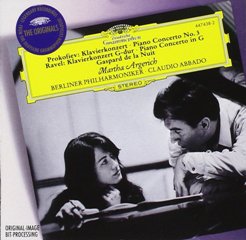Prokofiev - Piano Concerto No. 3 (Argerich) [1996]
Prokofiev - Piano Concerto No. 3 (Argerich) [1996]

1. Prokofiev: Piano Concerto No.3 In C, Op.26 - 1. Andante - Allegro 9:03 2. Prokofiev: Piano Concerto No.3 In C, Op.26 - 2. Tema con variazione 9:03 3. Prokofiev: Piano Concerto No.3 In C, Op.26 - 3. Allegro ma non troppo 8:59 Martha Argerich – piano Berlin Philharmonic Orchestra Claudio Abbado – conductor
For his third concerto for piano and orchestra, Prokofiev looked to the past for inspiration: this concerto incorporates material derived from sketches made between 1911 and 1918. The first movement contains two themes that were written in 1916, plus a chordal passage first sketched in 1911; the second movement contains a theme and variations that was written in 1913, while the final movement uses thematic material from a discarded string quartet begun in 1918. When he began composing this concerto during a holiday in Brittany, Prokofiev wrote, "I already had all the thematic material I needed except for the third theme of the finale and the subordinate theme of the first movement." The Third Piano Concerto is perhaps Prokofiev's best known essay in this genre, and approaches Tchaikovsky and Rachmaninov in popularity and frequency of performance. Its opus number places it just after the "Classical" First Symphony of 1917, and the concerto is, in its way, similar to the First Symphony is a number of ways: both works are lively, acerbic, with brilliant orchestration and a certain transparent texture. Both pieces are also clearly the work of a deft young composer of considerable technical skill; however, the two works differ greatly in regards to their reception. The "Classical" Symphony was reasonably well received in Russia, where it was performed only once before Prokofiev emigrated to the United States. Subsequent performances of the symphony in America were very successful. The Third Concerto, on the other hand, did not fare so well, and after a good premiere in Chicago (along with the opera Love for Three Oranges) in 1921, the work was roundly denounced in New York.
The concerto displays much of the "harmonic liveliness," in Nancy Siff's words, of the mid-period symphonies, with its sudden shifts from key to key and chromatic harmony. The sophistication and bravura generally associated with Prokofiev's music is ever present, as is the humor found in many of his orchestral works. The concerto is in a traditional three-movement concerto form (the only one of Prokofiev's five piano concertos to use the traditional form), beginning and ending with fast movements that flank a slow middle movement. Each movement is about the same length, and the thematic weight and interest is distributed evenly throughout the movements. The work begins with a vivacious opening movement, which includes a humorous march underlined by castanets, followed by the five variations of the second movement, and concludes with a grandiose display of colorful harmonies and virtuosic orchestration. The solo writing for the piano is also virtuosic, and at times quite percussive. --- Alexander Carpenter, Rovi
download: uploaded yandex 4shared mediafire solidfiles mega gett filecloudio nornar ziddu
Last Updated (Saturday, 22 March 2014 13:04)








